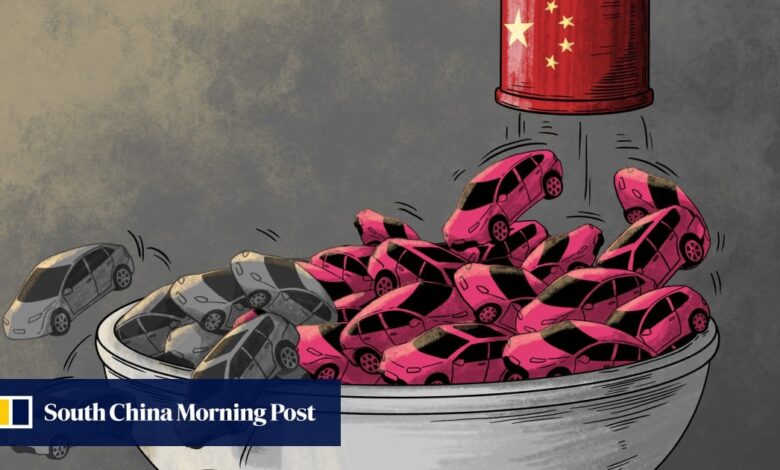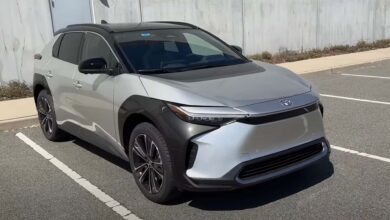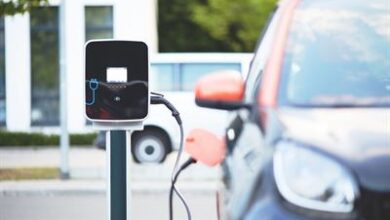How China’s EV overcapacity has come to a head after 15 years, and what’s in store for the industrial policy race with US and EU

But the blowback from abroad has ramped up relatively recently, as the fruits of China’s exhaustive EV undertakings truly began to be realised. Having long led the global pack in automobile and hi-tech manufacturing, the United States and European Union now find themselves scrambling to erect roadblocks to safeguard those sectors at risk of being upended by Chinese exports.
“The intention to hype up China’s overcapacity is to contain China’s industries that have an edge,” said an opinion piece in People’s Daily, adding that China was being made a “scapegoat” for the decline of various American sectors.
Meanwhile, some analysts contend that China’s EV glut is inherently different from the excess or idle capacity issues that once plagued other industries. Market mechanisms and Beijing’s strained ties with the West, they say, have also become factors at play as Chinese EVs sit squarely in the cross hairs of American and European politicians.
“A free market or industry is not immune from overcapacity,” said Zhu Tian, a professor of economics at the China Europe International Business School in Shanghai. “But, thankfully, the almighty market will eventually weed out uncompetitive players or excess capacity.
“The key is keeping politics out of this market mechanism.”
There are warning signs if we assume overcapacity means China is producing more than its domestic economy can consume
Overcapacity strikes back
China’s industrial-capacity utilisation rate dropped to a four-year low of 73.6 per cent in the first quarter, according to the National Bureau of Statistics (NBS).
“A utilisation rate of 76-80 per cent is considered normal for most industries,” Zhong Zhengsheng, chief economist at Shenzhen-based Ping An Securities, said in a recent report.
NBS data also revealed that automobile and new-energy equipment manufacturing were among the sectors grappling with deep drops in capacity utilisation during the quarter.
In 2023, just 20 of China’s 77 automakers reported above-60 per cent utilisation levels that are deemed to be in the normal range, a report by Shanghai-based consultancy Gasgoo revealed. Less than half of last year’s car-production capacity of 55 million was used.
“There are warning signs if we assume overcapacity means China is producing more than its domestic economy can consume,” Alicia Garcia-Herrero, French investment bank Natixis’ chief economist for the Asia-Pacific region, said in an April report, citing the asset-turnover and inventory-to-sales ratios.
There is also a consensus among domestic analysts. Guangxi-based Sealand Securities warned in an April research note that EV production accounts for just one of many sectors bogged down by overcapacity.
“Declines in prices and capacity utilisation, relative to their recent highs, suggest that the current round of overcapacity covers many industries,” the report said.
Using 2019 and 2021 capacity-utilisation ratios as benchmarks, Nanjing-based Huatai Securities also flagged electronics, pharmaceuticals, building materials, and food and beverage as sectors bedevilled by low utilisation.
Lu Feng, a professor with Peking University’s National School of Development, said at a recent seminar that overcapacity was more pronounced among producers of petrol vehicles, petrochemical goods, chips and lithium batteries.
Notwithstanding the speed and scale of China’s EV adoption and the tech self-sufficiency crusade fuelled by geopolitics and tech disputes, Lu raised concerns about some initial “signs of structural excess output” in the chip sector and lurking risks in the EV bonanza.
China’s chip-production capacity will grow by 13 per cent with 18 new projects in 2024, despite the capacity-utilisation ratio of the computer- and electronic-equipment sector hitting a historical low of 75.6 per cent last year, according to estimates by American semiconductor industry group SEMI.
Have times changed?
China is no stranger to overcapacity – not since opening up its manufacturing sector to private and foreign investors in the 1990s.
Still, the government and state-owned enterprises (SOEs) continue to be the main culprits. For instance, the 4-trillion-yuan stimulus package that Beijing wheeled out in 2008 to offset export losses, coupled with monetary and credit loosening, ignited frenzied production expansions for steel, cement, aluminium and plate glass, mostly among SOEs.
By 2013, when Xi Jinping became president, overcapacity started to bite in the photovoltaics (PV) sector, then spread to building materials and other industries.
But experts say the problem is not quite the same this time around.
“Today, overcapacity is concentrated in equipment manufacturing and downstream consumer industries, involving more private producers than SOEs,” said Zhong of Ping An Securities.
China’s EV sector is championed by private players such as BYD, which dethroned Tesla last year as the world’s largest producer. Similarly, the lithium battery sector is dominated by the privately run Contemporary Amperex Technology, known as CATL.
“It’s different from a decade ago, when SOE makers of steel, cement and non-ferrous metals were churning out more than needed,” he added.
And, unlike how China’s leaders relentlessly reined in these sunset industries back then, Beijing now hails EVs, PVs and lithium batteries as bright spots of its economy – China’s new darling industries. The combined export value of these “new three” trade pillars hit 1 trillion yuan (US$128 billion) last year, and they reflect a shift from China’s “old three” export pillars that comprised clothing, home appliances and furniture.
Zhong also pointed out how the transition of the Chinese economy has had a profound impact across industries.
“The population is ageing, potential growth declining, and property demand peaking … This means tougher competition among businesses for a bigger slice of a pie when the pie itself may not become too much bigger,” he said.
Occurring in tandem, a widespread shift toward deglobalisation and protectionism has seen policy focuses shift to de-risking, re-industrialisation and supply-chain security.
Zhong thus spotlighted the role of industrial policies in creating overcapacity in industries that specialise in computers, telecommunication equipment, electronics, electrical machinery and pharmaceuticals.
In the supply-side reform initiated by former vice-premier Liu He in 2015 to defuse the overcapacity crisis, Beijing once identified six of the hardest-hit sectors: iron and steel; cement; coal; aluminium; plate glass and shipbuilding.
Today, there are questions as to whether such intervention might still be warranted in sectors such as EVs, as the market is already driving out uncompetitive players, with a string of closures since last year amid an intensifying price war.
Zhu Jiangming, founder of Zhejiang-based Leapmotor, one of the top-10 EV sellers last year, was quoted by the state-backed Zhejiang Daily in April as saying that more consolidation was expected by 2025.
“By then, companies that survive the competition can carve out bigger market shares,” he said. “In a very dynamic market, there is new capacity coming online, but competition is also knocking out some producers.”
Beijing’s policymakers have signalled that central authorities will remain hands-off amid such a market-led restructuring, deeming it a necessary step to forge competitiveness among Chinese manufacturers.
Beijing has also emphasised that the rapid rise of China’s new-energy industries was in line with economic laws and market principles.
“The competitiveness of new-energy products like EVs traces its source to early planning, years of R&D investment, strong industrial support, and the sheer size of the domestic market,” foreign ministry spokesman Wang Wenbin said in April.
Adding that the advantages are shaped by market competition, Wang contended that the West’s characterisation of these industries’ dynamism as “overcapacity” smacked of trade protectionism.
Tensions with the West
Some analysts have also linked China’s rapidly inflated production capacity with its ambitions to dominate global supply chains, while a sluggish global economy and rising trade barriers are said to have exacerbated the overcapacity backlash.
After joining the WTO in 2001, China’s revved-up export machine propelled its economy to the world’s second-largest in about a decade. China also overtook Germany as the world’s top exporter in late 2009.
China’s mighty mass-manufacturing capacity is also seen in its capability to churn out a vast array of goods, from cheap daily necessities to high-precision instruments.
But against the backdrop of a febrile geopolitical climate and tech disputes, freewheeling output and export growth may be impeded as the US and Europe are closing ranks, alleging that Chinese goods are being dumped on them.
In response, Beijing has urged Washington not to politicise the issue or seek to contain China, while adding that policymakers on both sides of the Atlantic should embrace the fundamental principles of a market economy.
Lance Liangping Gore, a senior researcher with the National University of Singapore’s East Asian Institute, said “overcapacity” could be construed as a fuzzy or misleading term.
“EVs are just starting to replace gasoline vehicles, and the capacity is far from enough. It’s quite conceivable that global emission reductions will come faster – and cheaper for consumers – if China keeps producing at an optimal scale,” Gore said.
“The West’s concerns boil down to profits versus fighting climate change. In neither case is overcapacity the real issue,” he added.
But Jean-Pierre Cabestan, a senior researcher with France’s National Centre for Scientific Research, stressed that the motivation behind the West’s moves was more complex than just protecting a few uncompetitive producers.
“The stakes are high: saving the European car industry, and jobs and supply chains along with it,” said Cabestan, who is also a professor of international studies at Hong Kong Baptist University. “There is consensus in the EU that transcends election rhetoric and populism. European buyers may even prefer to pay more [for local EVs].”
In the first two months of 2024, China’s EV exports to the EU fell by 20 per cent, year on year, to 75,626 units.
Where is the industrial-policy race headed?
The International Monetary Fund found more than 2,500 industrial-policy interventions worldwide last year, and it said the surge has been largely driven by big economies, with China, the EU and the US accounting for almost half of them.
For Beijing, which is involved in planning and guiding industrial restructuring, it sees the so-called visible hand of a proactive government as an institutional advantage the West will never have.
“In China, one pair of hands looks after the economy – the ‘visible’ hand of government policies and macro-management – and an ‘invisible’ hand looks after the market and competition … Two hands are better than just one,” said Hu Angang, dean of the Tsinghua University’s Institute for Contemporary China Studies.
For China’s EV sector, industrial policies also served as the initial catalyst, combined with subsidies and the right bet on battery technologies during the industry’s infancy.
And after ushering in a boom that began in 2020, Beijing stepped back and let the market take the reins. But subsequent price wars and market saturation have drawn the ire of the West, prompting aggressive responses as Chinese manufacturers increasingly seek to go global.
Christopher Tang, a University of California Los Angeles professor specialising in global supply-chain management, said the US’ relative shortfall in competitiveness could end up hitting its drivers in their wallets.
“Washington fails to acknowledge that China has developed efficient supply-chain solutions – from raw materials to end products – to mass produce at low prices,” he said. “Raising barriers will rob Americans of their access to good, cheap products.
“US manufacturing has never been competitive. Washington blamed Japan first, and now China.”
But moving forward, Chinese automakers cannot resolve the US-market-access issue the way Japanese carmakers did in the 1980s, according to Tomoo Marukawa, an economics professor with the University of Tokyo.
“The influx of Japanese cars frustrated American politicians, but the issue was resolved by Toyota and Honda investing in the US to have US workers assemble cars,” he said. “But Washington will deny Chinese investments, even from non-SOEs.
“Perhaps Mexico may allow the Chinese to make EVs there and sell them to the US. But Washington may still block those imports by any means.”
As a result, the reality is that Chinese EVs – as determined as their manufacturers are to find a way into the US – could wind up on a political collision course.



